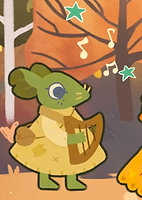
Level Rational Design
Le Beau Tambour
Le Beau Tambour is a text-based narrative game whose mechanics rely on the player's attention to what is happening, emotions and music. While following the adventures of Grenouille, the player meets characters as crazy as they are endearing and tries to solve their problems with the blow of a drum stick! The player must pay attention to the reactions of his musicians to choose the right melody to play, which will accentuate a particular emotion. This emotion will then dictate what answer the musician replies during the dialogue with the character blocking their path. The player thus changes the relationships of his characters and their feelings.
The first job as Level and Narrative designer was to define the narrative system that would drive the experience and create an evolution of the difficulty. Working with the programmers, we came up with a choice branching system tied to the chosen emotions.

Defines the dialogue that will run
Choice of musician
Choice of the story arc in which we will evolve.


Choice of emotion
Choose an emotion according to the clues present in the dialogues and the behavior of the musician.


IF the emotion is compatible:
The following dialogue advances the musician's story.
IF the emotion is NOT compatible:
The following dialogue brings new clues to compatible emotions, but does not advance the story, the player must try again.
This dialogue choice system involves the creation of dialogue trees leading to different frames. These trees were created in several steps: creation of the basic tale (material), creation of the dialogue tree and narrative arcs, and finally integration into a Google Sheet linked to the Unity project.

Writing the chapter story

Dialogue tree, different evolution of the musicians depending on the player's choices

Integration of dialogues in the Google Sheet with tags and identifiers.
Once the dialogues written, it is necessary to take care of the emotional tags created by the programmers and to test the coherence of the narration with the different possible dialogue sequences. The game's emotion tags are instantiated via the Google Sheet directly, so emotion management was also part of my responsibilities. These are these tags that will define the evolution of the level design and the difficulty of the game.

Dialogs once the step of adding tags is complete.

"Your honey in exchanges for my family's most precious possession! Where's the cheat <? E: React / Trust, Mouse, TRUE />?"
<? E: ReactionType / Emotion, TargetCharacter, Stop textDuringReation />
The mouse produces Confidence Vfx. The text stops for the duration of the VFX.
Thanks to all these tools, it was possible for me as author to create different evolutions of each character depending on the emotions that the player chooses to play. The mouse facing the cat can therefore end up frightened or compassionate. His narrative arc will evolve and define a character trait for the rest of the adventure. These emotion tags will change the game and depending on the different attributes applied at the end of the chapter, these tags will evolve and thus the level design is renewed.
